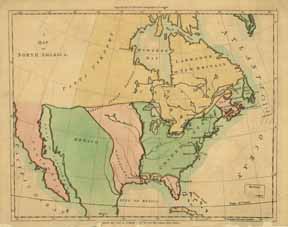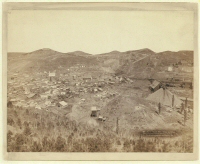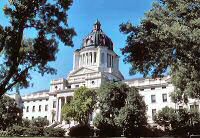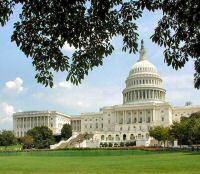 |
Map Showing Louisiana Purchase (Pink)
Courtesy: Library of Congress |
STATEHOOD:The land called South Dakota was purchased from
France in 1803 as part of the Louisiana Purchase. Lewis and
Clark visited parts of South Dakota with the Corps of Discovery as they made
their way up the Missouri River in 1804 and on their return trip in 1806.
Reports of an abundance of fur-bearing animals brought trappers and fur
traders to South Dakota and led to the establishment of the first western
settlements in the area.
Between 1812 and 1834, South Dakota was part of the Missouri
Territory but for twenty years, from 1834 through 1854, the eastern and western
parts of the state followed separate paths. While western South Dakota
remained a part of the Missouri Territory until 1854, eastern South Dakota
became, alternately, part of the Michigan, Wisconsin, Iowa, and Minnesota
territories. In 1854, western South Dakota became part of the Nebraska
Territory.
South Dakota began to come into its own when Congress created the
Dakota Territory in 1861. Dakota Territory, named for the Native Americans of
the area, consisted of present-day North and
South Dakota and much of Montana and Wyoming. Yankton was the capital
 |
Great Homestake Mines and Mills 1889
Courtesy: Library of Congress |
The discovery of gold in the Black Hills in the mid-1870s and
a land rush that began in 1878 brought prospectors, farmers and more land
speculators to South Dakota. More than 24 million acres of public
land was distributed from 1878-1887.
As population centers grew far apart in the Dakota Territory, a
movement emerged in the 1870s to divide the territory into multiple parts
with separate governments. Proposals were made to divide the territory into
eastern (Eastern Dakota) and western (Western Dakota) sections or into
northern (Pembina Territory) and southern (Dakota) sections. One proposal
divided the state into three sections; North Dakota; South Dakota; and the
Black Hills. This movement grew stronger when Territorial
Governor Nehemiah Ordway moved the capital out of Yankton northwest to
Bismarck.
Dakotans in the southern part of the state went to work, meeting
in Sioux Falls. They wrote a constitution and pushed for statehood in the
United States Congress. On February 2, 1889, Congress set the boundary between
North and South Dakota passing an
enabling act
which allowed the two sections to take the necessary steps toward statehood.
On Nov. 2, 1889, North Dakota and South Dakota entered the Union as the 39th
and 40th states. |
| |
|
STATE CONSTITUTION:A constitution sets out the rules by which we play the game
of government. Like the rules for any other game, it limits the moves available to players. It describes how
the various players interact with each other, and who has more power in various situations.
The first constitutional convention seeking South Dakota statehood
was held in 1883. A second convention was held two years later in 1885. The
constitution adopted in 1885 is the same constitution written in 1883 with additions,
corrections and deletions. In fact, on the original copy of the 1883 constitution
a 5 is written over the 3 changing the date from September 1883 to September 1885.
The document is concluded, "Done at Sioux Falls this 25th day of September 1885".
On August 17, 1889, a third convention drafted the final constitutional provisions to meet
requirements of the Enabling Act of 1889. It was adopted by the people of South
Dakota on October 1, 1889. South Dakota is governed under this constitution adopted in 1889,
as amended.
PREAMBLE:We, the people of South Dakota, grateful to Almighty God for our
civil and religious liberties, in order to form a more perfect and independent government, establish
justice, insure tranquillity, provide for the common defense, promote the general welfare, and preserve
to ourselves and to our posterity the blessings of liberty, do ordain and establish this Constitution
for the State of South Dakota.
[ SOUTH DAKOTA CONSTITUTION ] |
| |
|
STATE MOTTO:One of 21 English state mottoes, Under God, the People Rule is
also one of only four state mottoes that express a religious sentiment.
The South Dakota motto, like others, was adopted as part of the state
seal. It was suggested by the Reverend Joseph Ward, founder of Yankton College, at
the 1885 Constitutional Convention. It was adopted as the South Dakota motto, as
an element of the state seal in the 1885 constitution and in the 1889 constitution.
The wording in the constitution pertaining to the seal reads:
Properly divided between the upper and lower edges of the circle shall appear the legend, "Under God the People Rule" which shall be the motto of the state of South Dakota. |
| |
|
STATE GOVERNMENT:As in the case of the federal government, South Dakota's state government is
organized into three branches - executive, legislative, and judicial. The state government is a product of
three documents: the United States Constitution, the South Dakota State Constitution, and laws of the state.
The Governor of South Dakota is the chief executive officer of the state and is elected for a
four-year term and may not serve for more than two terms in a row. He or she is responsible for appointing
certain state officers, veto or approval of bills passed by the Legislature, granting pardons and paroles,
calling special sessions of the legislature, and commands the state militia. The Governor is also
responsible for the preparation of the state budget, and ensures that all laws are obeyed in the state.
The South Dakota State Legislature is the lawmaking branch of the state government. The
Legislature has the authority to pass laws that people must obey. The Legislature is also responsible
for raising and distributing the money necessary to run the state government. The South
Dakota Constitution states that "...the number of members of the house of
representatives shall not be less than fifty nor more than seventy-five and
the number of members of the senate shall not be less than twenty-five nor
more than thirty-five."
 |
The judicial branch of the South Dakota Government interprets the
laws. The South Dakota Court System includes a Supreme Court and trial courts
called Circuit Courts. The Supreme Court consists of a chief justice and four
associate justices. When a vacancy occurs, Judges on the Supreme Court are
initially appointed by the governor from people nominated by the judicial
qualifications division. After initial appointment, Supreme Court Judges must
be elected to eight-year terms by the citizens of South Dakota.
Circuit court judges are elected for eight-year terms by the citizens of the
circuit each represents.
[ BRANCHES OF SOUTH DAKOTA GOVERNMENT ]
[ EXECUTIVE BRANCH ]
[ LEGISLATIVE BRANCH ]
[ JUDICIAL BRANCH ]
[ GREAT SEAL OF SOUTH DAKOTA ]
[ SOUTH DAKOTA STATE FLAG ] |
| |
 |
| Governor Dennis M. Daugaard |
GOVERNOR:Dennis M. Daugaard (Republican)
FIRST LADY:Linda Daugaard
[ GOVERNOR'S PAGE ]
[ FIRST LADY ]
[ FORMER STATE GOVERNORS ]
[ GOVERNOR'S RESIDENCE ]
|
| |

South Dakota State Capitol Building
Courtesy of SD Office of Tourism |
SOUTH DAKOTA CAPITOL BUILDING:
Location:Pierre
Date Erected:1905-1910
- The city of Pierre incurred a 30-year debt because of the amount of money they spent to become the capital city.
- Constructed of native fieldstone, Indiana limestone, Vermont marble, Italian marble.
- A modified version of the Montana State Capitol, it was designed and built for just under $1,000,000 by Minneapolis architects C.E. Bell and M.S. Detwiler.
- Government agencies began moving in during the summer of 1910.
- North entrance added as annex in 1932.
- A restoration project to restore the building to its original appearance took place between 1977 and 1989 in time for South Dakota's Centennial Celebration.
- According to legend, 66 Italian artists who layed the Terrazzo floor left 66 blue signature stones. Only 55 have been found.
- In each corner under the dome are large murals of Greek goddesses which symbolize major interests in South Dakota.
[ ABOUT ]
[ WEB CAM ]
[ TOUR ]
[ VIDEO TOUR ] |
| |
| STATE REPRESENTATION:The South Dakota Legislature is composed of
two bodies, called houses, like the United States Congress. The two parts are the Senate and the House
of Representatives. The Legislature is referred to as a bicameral body because it is made up of two houses.
The Latin roots of the word bicameral, "bi" and "cameral," mean two chambers or rooms. The Legislature
is responsible for making the laws in South Dakota and for raising and distributing the money necessary to run the
state government. The South Dakota Constitution states that "...the number of members
of the house of representatives shall not be less than fifty nor more than
seventy-five and the number of members of the senate shall not be less than
twenty-five nor more than thirty-five."
[ SOUTH DAKOTA LEGISLATURE ]
[ STUDENTS PAGE ] |
| STATE REPRESENTATIVES:Representatives in South Dakota each represent
people in a specific area of the state. These areas are called house districts. There are currently 70 men
and women representing 35 house districts in the South Dakota House of Representatives (Two elected from each
district). 48 representatives are
Republicans and 21 are Democrats. Each representative serves for a period of two years in the House of
Representatives, after which he or she must run for re-election. A representative may not
serve for more than four consecutive terms (8 consecutive years) in the House of
Representatives.
[ STATE REPRESENTATIVES ]
[ LEGISLATIVE DISTRICTS ] |
STATE SENATORS:Senators in South Dakota each represent people
in a specific area of the state. These areas are called senate districts. There are currently 35 men and
women representing 35 senate districts in the South Dakota Senate. 26 representatives are Republicans and 9 are
Democrats. Each senator serves for a period of NUM years in the Senate, after which he or she must run for
re-election. A senator may not serve for more than four consecutive terms (8 consecutive years)
in the Senate.
[ STATE SENATORS ]
[ LEGISLATIVE DISTRICTS ] |
|
| |
|
LEGISLATIVE PROCESS:The legislative branch of government is responsible for making and
maintaining laws within their jurisdiction. United States representatives and senators, federal legislators,
are responsible for laws at the national level and state legislators are responsible for laws at the state
level. A law begins as an idea that is introduced in the South Dakota Legislature as a bill by one or more
legislators. The bill then goes through the legislative process to become a law. During this process the bill
may be changed. Not all bills become law.
[ HOW A BILL BECOMES LAW IN SOUTH DAKOTA ] |
| |
| CURRENT LEGISLATION:When the legislature is meeting, it is said
to be "in session." The South Dakota Legislature meets annually. The sessions
begin (convene) every year on the second Tuesday in January at noon. The state
constitution limits the number of days that the legislature may be in session. In
odd-numbered years, the legislative session is limited to 40 legislative days. In
even-numbered years, the session is limited to 35 legislative days. Legislative days
do not include Sundays, holidays or "recess" days.
In addition to regular sessions, the governor or the legislature may convene
"special sessions" when the need arises to enact important legislation.
The following link will allow you to look at bills that are currently going through the legislative process.
[ CURRENT LEGISLATION ] |
| |
| STATUTES:The following link will allow you to look at
South Dakota's current laws.
[ SOUTH DAKOTA REVISED STATUTES ] |
| |
| COUNTIES:The United States Constitution does not define local government.
Instead, this function is left up to the states.
Counties are a local unit of government within a state. All but two of the states are divided into
counties. Alaska is divided into boroughs and census districts and Louisiana is divided into parishes where
governing responsibilities are similar to counties.
Traditionally, counties performed tasks mandated by the state, such as property assessment, property and vital
statistic record keeping, maintenance of rural roads, administration of local election and judicial functions,
and support of the poor. Today, counties may be responsible for these functions, more or less, but the
responsibilities of county governments vary from state to state.
| COUNTY TRIVIA:
- There are 66 counties in South Dakota.
- The largest county is Meade County, at 3,476 square miles.
- The smallest county is Clay County, at 412 square miles.
- Minnehaha County is the most populated county with 148,281 people (2000 census).
- Jones County is the least populated county with 1,193 people (2000 census).
[ ABOUT COUNTY GOVERNMENT ]
[ SOUTH DAKOTA COUNTIES ]
[ ASSOCIATION OF U.S. COUNTIES ]
[ US CENSUS BUREAU ]
[ COUNTY MAPS ] |
|
| |
 |
United States Capitol Building
Washington, DC |
U.S. CONGRESSIONAL DELEGATION:
The legislative branch of the United States government makes laws for our nation and raises and distributes
money to run the United States government. The most evident part of the legislative branch is the United
States Congress. Congress is divided into two parts, called houses. The two parts are the Senate and the House
of Representatives. Congress is referred to as a bicameral body because it is made up of two houses. The Latin
roots of the word bicameral, "bi" and "cameral," mean two chambers or rooms. Members of the Senate are called
Senators and members of the House of Representatives are called Representatives. Senators and representatives
serving in these two bodies are sometimes referred to as congressmen, or women, and sometimes as legislators
because their business is to legislate or make laws. The role of the legislative branch is defined in the
United States Constitution.
[ THE UNITED STATES CONSTITUTION ]
Each state elects people to represent them in the United States Congress in Washington, DC. The citizens of each
state elect two senators to represent them in the Senate. They also elect representatives to represent them in
the House of Representatives. The number of representatives each state sends to the House of Representatives
is not a specific number like the Senate, but is based on the population of the state. The people, that are
elected to represent the state's citizens in the United States Congress, are referred to as the congressional
delegation.
There are 100 senators in the U.S. Senate. Each is elected to a term, in the Senate, of six years. There are 435
representatives in the U.S. House of Representatives. Each is elected to a term, in the "House," of two
years.
The citizens of South Dakota elect two people, like every other state, to represent them in the
Senate and 1 person, based on South Dakota's population, to represent them in the House of Representatives.
| U.S. House of Representatives (1): |
|
|
| |
|
broken links to us. We really appreciate it. |
Source: State of South Dakota Web Site, (http://www.state.sd.us), August 12, 2004
Source: Office of the Governor of South Dakota, (http://www.state.sd.us/governor/), Sebtember 11, 2004
Source: South Dakota Legislature, (http://legis.state.sd.us/index.cfm), September 11, 2004
Source: National Governor's Association, (http://nga.org), September 11, 2004 |

 |
|
|
[ HOME
|| INTRO
|| SYMBOLS
|| ALMANAC
|| ECONOMY
|| GEOGRAPHY
|| STATE MAPS
|| PEOPLE
|| GOVERNMENT
]
[ FORUM
|| NEWS
|| COOL SCHOOLS
|| STATE QUIZ
|| BOOK STORE
|| MARKETPLACE
|| STATE LINKS
]
|| GUESTBOOK
|| CONTACT US
|| PRIVACY STATEMENT
] |
Site designed exclusively for NETSTATE.COM by NSTATE

NETSTATE.COM is a Trademark of NSTATE, LLC.
Copyright © 2003- by NSTATE, LLC. All rights reserved.
No copyright is claimed on non-original or licensed material.
Support NETSTATE
Top |
|



